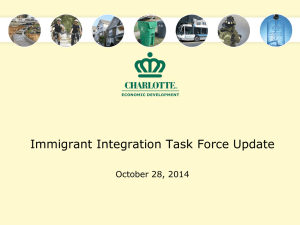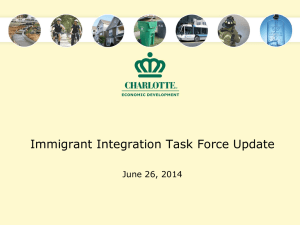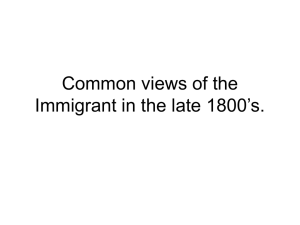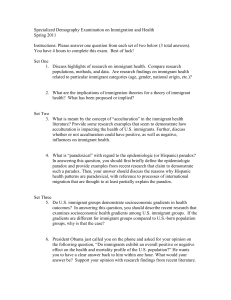Letter The Claremont
advertisement
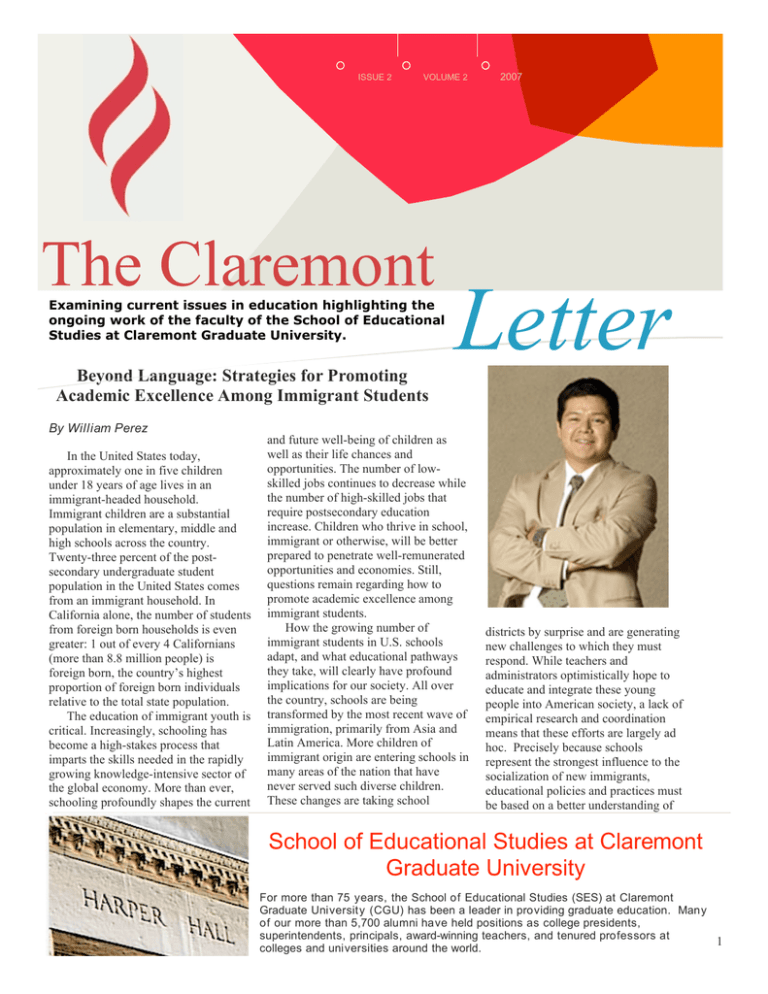
ISSUE 2 VOLUME 2 The Claremont Examining current issues in education highlighting the ongoing work of the faculty of the School of Educational Studies at Claremont Graduate University. Education Beyond Language: Strategies for Promoting Academic Excellence Among Immigrant Students By William Perez In the United States today, approximately one in five children under 18 years of age lives in an immigrant-headed household. Immigrant children are a substantial population in elementary, middle and high schools across the country. Twenty-three percent of the postsecondary undergraduate student population in the United States comes from an immigrant household. In California alone, the number of students from foreign born households is even greater: 1 out of every 4 Californians (more than 8.8 million people) is foreign born, the country’s highest proportion of foreign born individuals relative to the total state population. The education of immigrant youth is critical. Increasingly, schooling has become a high-stakes process that imparts the skills needed in the rapidly growing knowledge-intensive sector of the global economy. More than ever, schooling profoundly shapes the current 2007 Letter and future well-being of children as well as their life chances and opportunities. The number of lowskilled jobs continues to decrease while the number of high-skilled jobs that require postsecondary education increase. Children who thrive in school, immigrant or otherwise, will be better prepared to penetrate well-remunerated opportunities and economies. Still, questions remain regarding how to promote academic excellence among immigrant students. How the growing number of immigrant students in U.S. schools adapt, and what educational pathways they take, will clearly have profound implications for our society. All over the country, schools are being transformed by the most recent wave of immigration, primarily from Asia and Latin America. More children of immigrant origin are entering schools in many areas of the nation that have never served such diverse children. These changes are taking school districts by surprise and are generating new challenges to which they must respond. While teachers and administrators optimistically hope to educate and integrate these young people into American society, a lack of empirical research and coordination means that these efforts are largely ad hoc. Precisely because schools represent the strongest influence to the socialization of new immigrants, educational policies and practices must be based on a better understanding of School of Educational Studies at Claremont Graduate University For more than 75 years, the School of Educational Studies (SES) at Claremont Graduate University (CGU) has been a leader in providing graduate education. Many of our more than 5,700 alumni have held positions as college presidents, superintendents, principals, award-winning teachers, and tenured professors at 1 colleges and universities around the world. the cultural and academic orientations of its diverse students. Currently, educating immigrant youth focuses almost strictly on English language acquisition. Students are placed on the English Language Development (ELD) track, often with a watered-down curriculum and low academic expectations. In addition, a variety of implicit and explicit techniques encourage students to quickly assimilate into mainstream American culture and shed any traces of their culture of origin and native language. Unbeknownst to schools and educators, it is these characteristics that may give immigrant children the strongest sense of belonging and encourage academic achievement. In this article, I argue that our efforts to educate immigrant youth need to expand beyond a sole focus on language. Focusing solely on getting immigrant students to become English Proficient is short-sighted and inadequate. Efforts to educate immigrant youth need to include recognition of the various cultural and psychological resources that students bring into the classroom setting. First, I discuss the research literature that describes the cultural and psychological characteristics that immigrant youth bring into the context of learning. Second, I detail the damaging effects of forced linguistic and cultural assimilation and show how these schooling practices undermine the achievement motivation of immigrant students. Finally, I suggest classroom and school practices that can be implemented to support and nurture academic excellence among immigrant youth. Section I: Psychological and Cultural Resources Although economic and human capital affect the educational adjustment of immigrant youth, these students also possess a variety of cultural and psychological resources that are significant contributors to academic success, according to the educational research literature. These resources include immigrant optimism, biculturalism, bilingualism, and a strong family orientation. Immigrant Optimism Although immigrant students face many difficulties in the U.S. including English language acquisition, a general lack of familiarity with the customs and expectations of the new country, limited economic opportunities, poor housing conditions, discrimination, and the stress of adjusting to a new culture, educational research with immigrant youth suggests that these students display achievement patterns that surpass those of their nativeborn counterparts. The evidence of immigrants’ achievement drive is well documented by empirical research. Immigrant parents have strong ambitions and optimism. Students have high expectations, school commitment, and a work effort that consistently exceeds the effort of the general student population. Immigrant students have superior grades and lower dropout rates than their third-generationand-higher-peers. Family Orientation Research suggests that a strong allegiance to family may increase the academic engagement of Asian and Latino immigrant youth. In particular, these students often view school success as one of the most important ways they can assist their families. Asian and Latin American parents often emigrate to the United States in order to provide their children with better opportunities, including the chance to pursue an advanced education. Ethnographers report that some students say that they would feel guilty not trying hard in school, given the many personal and professional sacrifices their parents made to come to this country. Other adolescents believe that their educational attainment will help them secure employment and support their families in the future. Students from Asian American and Latino families often cite such indebtedness and responsibility as their primary motivations to do well in school. Students with a strong family orientation appear to remain academically motivated over time when compared to peers with low levels of family orientation. As these students transition from elementary to middle school there is no decline in academic motivation for students who endorsed family obligation compared to students who did not. Although the transition to high school is associated with a rapid decline in the value of academic success continuing throughout the high school years, this decline is notably and significantly lessened for immigrant students who evince a strong sense of duty to support and assist their families. ENGAGEMENT SOCIAL JUSTICE ACCOUNTABILITY “The faculty of the school of educational studies believes a socially just nation educates all its diverse citizenry through networks of effective and accountable organizations that interact responsibly with families and communities…” -From our mission statement 2 Biculturalism, Bilingualism, & Cultural Brokering Immigrant parents are able to maintain connections and bonds with their children through shared cultural values. Since immigrant parents are not able to learn English as rapidly as their children, children who remain fluent in their parent’s native language can conserve and develop strong social bonds. One of the ways in which immigrant children are able to do this through interpreting and translating activities which researchers have termed Cultural Brokering (CB). CB entails translating and interpreting language as well as explaining American culture to adult family members. In a research study with Mexican-heritage students my research colleagues and I found that the many adult-like experiences of children who translate and interpret from English to the parent’s language and vice-versa on a regular basis accelerate these children’s cognitive and socioemotional development. CB often entails transactions that involve adults, which means that CB students must be able to comprehend, interpret, and translate messages using vocabulary and concepts that are very sophisticated for children of their age. These cognitively demanding experiences may directly aid their academic performance as well as give rise to perceptions of academic selfefficacy. Because they are interacting with adults and professionals, CB students may develop mature interpersonal skills that foster perceptions of social self-efficacy. In order to explain U.S. culture and society to their parents, CBs must develop and maintain sociocultural competencies in both their native culture and EuroAmerican culture, giving them a strong bicultural orientation. Interpersonal experiences with two languages and two cultures may impart enhanced feelings of self-confidence in social interactions. Greater experience, competence, and comfort in two cultures may provide bicultural students with more problem-solving strategies, interpersonal skills, and self-confidence for accessing academic resources at school and in their communities. Bicultural students may feel more at ease interacting with teachers and non-Latino students at school while also being amenable to tutoring Spanish-speaking adults in their community. Moreover, bicultural adolescents are better adapted to their dual cultural environment, which minimizes the detrimental effects of acculturation, such as psychosocial and behavioral disorders that can detract from academic performance. My own research and data from longitudinal studies by Alejandro Portes and Ruben Rumbaut highlight the benefits of biculturalism and bilingualism that result in fluent bilinguals with higher self-esteem, higher educational and occupational expectations, and higher academic achievement. Children who learn the language and culture of their new country without losing those of the old have a much better understanding of their place in the world. They do not clash with or feel embarrassed by their parents as often because these children can bridge the gap across generations and value their elders’ traditions and goals. Biculturalism forges an intergenerational alliance for successful adaptation that is absent among youth who have severed bonds with their past in the pursuit of acceptance by their U.S. born peers. Section II: Forced Linguistic and Cultural Assimilation Despite the achievement patterns that we see among immigrant youth who are able to maintain high levels of biculturalism and bilingualism, recent studies suggest an unsettling pattern: among immigrants today, length of residence in the United States seems associated with declining school achievement and aspirations. In other words, acculturation today leads to more ambivalent attitudes toward school and lower grades. In a five year study of over five thousand students from immigrant households, Alejandro Portes and Ruben Rumbaut (2001) found that “US nativity and long term residence among the foreign-born increase English skills but significantly lower grades…These findings strongly suggest that second generation children gradually lose their achievement drive with increasing acculturation” (p.239). If children immigrate at a very early age and if the parental culture and language are not reinforced, children will experience an eventual loss of parts or all of the home language and/or culture. In turn these children acquire accumulated knowledge of American culture and language through school and peers. The longer an immigrant child spends in American schools, the greater is their potential for acculturation to the mainstream society. My research suggests that immigrant cultural orientation diminishes across generations while American cultural orientation increases in a similar pattern. These findings suggest that within a few generations, most Latino adolescents exhibit a predominant American culture orientation while only maintaining decreasing traces of their Hispanic culture. Other researchers have concluded that the maintenance of ethnic loyalty, not assimilation, appears associated with stronger school performance among immigrant children. Although many educational as well as political leaders have adopted some components of the multicultural discourse, a close examination of actual educational and other multicultural policies has not been consistently implemented. Ethnographic research concludes that schools seek to quickly assimilate immigrants into an assumed American mainstream. Schools hasten assimilation by discouraging children from speaking their native language at school, which often results in alienation and disengagement from school. Forceful assimilation has other negative consequences. Policies derived from this ideology delegitimize the culture and language of parents. By instilling in children the sense that their parents’ language is inferior and should be abandoned in favor of English, schools help drive a wedge across generations. The weakening of parental efforts to monitor student behavior and preserve a common cultural memory results in lower levels of self-esteem, educational expectations, and academic achievement. Eventually, these school practices lead to the rise of defensive identities. Section III: Recommendations for Classroom Practices and School Policies School districts all over the country face unprecedented changes with few roadmaps. What educational strategies are effective for which students in which contexts? What are the factors that both positively and negatively influence immigrant children’s academic engagement and outcomes? An important step would be for schools to recognize the psychosocial and culturally based 3 structures that mediate school engagement that I have outlined in this essay. Unfortunately, educators are often not aware of these important resources and thus do not include them in educational practices. Schools must expand their practices to include factors that directly speak to the experiences of immigrant students. It would be an important step in maintaining engagement of a growing sector of the school-aged population in the United States. The optimism and relatively better academic record reflect a residual immigrant drive that weakens with the passage of time under the continuous influence of an adverse social environment. Biculturalism is particularly important for immigrant students. In many immigrant families, the only thing going for the children is the support and ambition of their parents. Thus, these aspirations should strengthened by encouragement rather than undermined. I propose two ways in which teachers and school administrators can support the cultural and psychosocial resources of immigrant youth. First, teachers who work with immigrant youth should be educated about how to best support immigrant youth. Workshops that outline educational research on immigrant youth, like that discussed here, could be used as part of ongoing professional development efforts. This approach would not require a large allocation of resources. Often teachers assume immigrant students are less capable due to their lack of English language proficiency and as a result, they lower expectations from students which result in self-fulfilling prophecies. Secondly, school administrators, particularly those in charge of professional development, ELD programs and curricula could support, encourage, and demand that teachers nurture immigrant students’ cultural and psychosocial resources to foster academic achievement. A more comprehensive approach would be for teachers to receive relevant training during the credentialing process. Biculturalism requires a socially and politically supportive environment where learning of English and American culture takes place in a paced fashion, without losing valuable cultural resources in turn. Public schools tend to discourage rather than support biculturalism and instead adopt an assimilationist stance. Assimilationism sustains a vision of an integrated society composed of wellbehaved citizens who share key values and normative commitments. There is nothing wrong with that vision, but the proposed way of achieving it is mistaken. We cannot get there by pressuring immigrants and their children into a uniform mold. Instead, we must make use of the values and resources that our new arrivals have brought with them. These are resources that provide immigrant youth with the necessary sense of self-worth and normative guidance to succeed in the face of multiple external challenges. By remaining fixed on the past, assimilationists neglect the major changes that have taken place in the world and in the U.S. economy during the last twenty-five years. At present, immigrant-sending countries are increasingly part of a single global web with the United States at its center. In this new world order where multiple economic, political, and cultural ties bind nations more closely to one another, it is not clear that the rapid extinction of foreign languages is in the interest of individual citizens or of society as a whole. In an increasingly interdependent global system, the presence of pools of citizens able to communicate fluently in English plus another language and to bridge the cultural gap among nations represents an important collective resource. Claremont Graduate University CGU is a member of the Claremont Consortium of seven institutions of higher education (Pomona College, Harvey Mudd College, Claremont McKenna College, Scripps College, Pitzer College, and Keck Graduate Institute). It is an independent institution devoted entirely to graduate education. Claremont Graduate University School of Educational Studies Harper Hall 202 150 East Tenth Street Claremont, CA 91711 Phone (909) 621-8317 Fax (909) 621-8734 E-mail ses@cgu.edu Web http://www.cgu.edu/ses William Perez is Assistant Professor of Education at Claremont Graduate University. An applied developmental psychologist, his program of research focuses on immigrant adolescent social development, academic achievement, and acess to Higher Education. The Claremont Letter is published three times per year in the fall, winter, and spring. I f you would like to subscribe or unsubscribe please send an e-mail to ses@cgu.edu. 4
